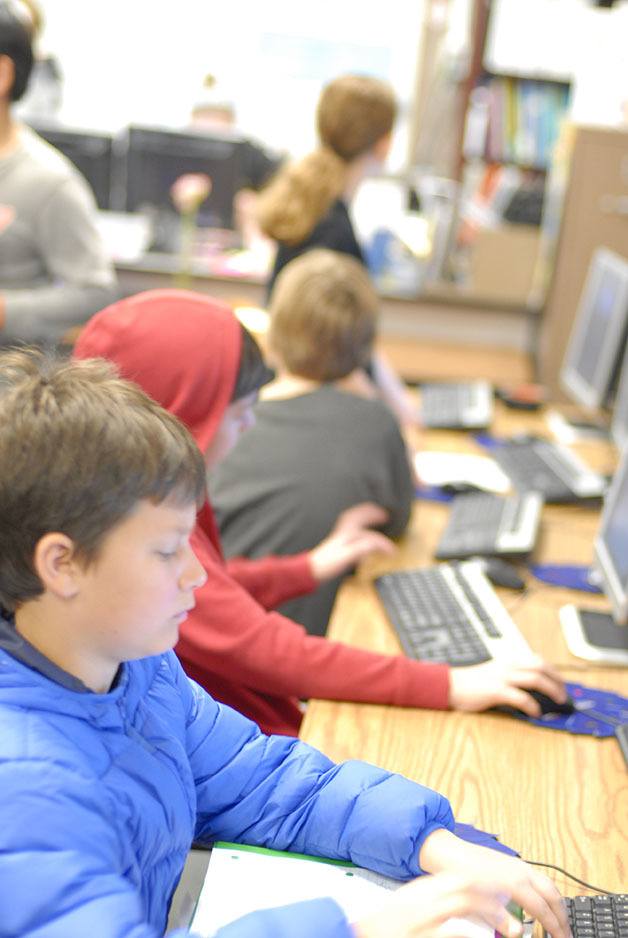It’s just a few days before the Fall City Elementary School science fair, and Betsy Sorenson’s fifth-grade classroom is full of energy, ideas, and students. Two more girls enter minutes before the end of class; they’d been working outside with Sorenson’s permission because they needed a quiet place to finish up their presentation.
Not exactly crowded, this portable classroom installed near the school playground is definitely cozy. An aquarium is perched on top of a filing cabinet stacked with books, plant experiments line the window sills, student cubbies are full of jackets and packs, the desks are littered with papers and students are gathered in groups on the floor, at the computer, wherever there’s some space to work.
As the bell sounds, another, slightly larger group of students files in to work on their science fair projects, while Sorenson’s students go next door for language arts.
Sorenson’s portable, where she’s taught her entire time at FCES, is the clear destination for the more hands-on projects of fifth graders.
What makes it all work is Sorenson’s solid structure for each class period, and the invaluable help of volunteer parents like Mike Hedrick. It also doesn’t hurt that the portables, removed from the main school building and reserved for the older students, are actually quieter and sometimes more comfortable than the brick-and-mortar classrooms.
“I actually prefer the portable,” says Sorenson, for those reasons.
Carl Larson is not surprised. As the plant operations manager for the Snoqualmie Valley School District, he hears from many of the teachers in the district’s 59 portable classroom units that they would rather stay put than move to permanent buildings. Maybe it’s because the portables, at roughly 1,000 square feet each, are no more or less crowded than a typical classroom. Maybe it’s the windows, or the quick access to the outdoors. Whatever else it may be, it’s definitely the climate control.
“Each portable has its own heat pump,” Larson said, so these classrooms are usually cooler on those warm spring days than any classroom in the main building.
They are misnamed, though, Larson points out. “They’re really more modular buildings,” he said. Intended as temporary classroom space for schools that don’t have enough permanent capacity for the growing numbers of students, the structures are neither portable nor temporary, once they’re installed on-site to the district’s standards.
Each unit, usually two classrooms to a portable, must have a 100-mph roof, cement-board lap siding, a more durable carpet, thicker floor joists to keep the room from bouncing, thicker walls with more insulation and improved doors and hardware for security from weather and theft.
All of these standards are upgrades from the standard bare-bones portable, Larson says, but they are necessary for the district’s climate.
“You can get anything you want in a portable,” he adds, “you just have to pay for it.”
“And if you buy the cheapest portables, you end up with a lot of maintenance costs,” added district finance manager Ryan Stokes.
A portable unit of two classrooms averages about $100,000 installed, but Stokes says the costs vary widely with the location, because of siting issues such as being in the floodway and infrastructure items like water and sewer, electrical, network needs and permit costs.
Most of the portable classrooms don’t have running water, for instance. Drinking water is available from water coolers in each classroom, and weekly deliveries of a half-dozen bottles to each classroom. To go to the restrooms, students must go outside to the main building, which was a lot easier before school officials increased security in December. Now with all the side doors locked, students must trek around the building to come in the front door, “but we’re used to it now,” said one student.
Electrical service is wired over from the school building, usually through suspended cables. Network service comes in the same way, except in the collection of portables in the Mount Si High School parking lot. These buildings include a network server room with its own network drop and wireless, plus restrooms and running water in all the classrooms.
The school district will add 14 new classrooms, three double units at Chief Kanim Middle School, three at Twin Falls Middle School and one at Cascade View Elementary School in June, to prepare for next year’s changes. Snoqualmie Middle School will be added to the Mount Si High School campus as a freshman-only school, and students who would have gone to SMS will be transitioned to Chief Kanim or Twin Falls, neither of which has the permanent capacity for the increased enrollment.
Next week, get a closer look at the effect of portables on student education.



